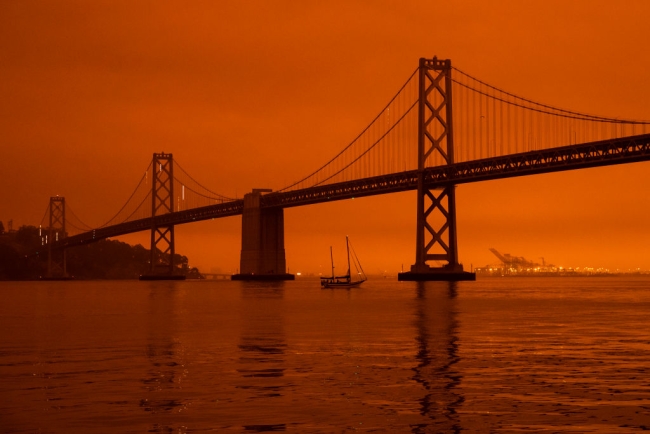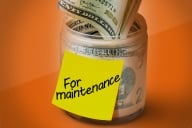You have /5 articles left.
Sign up for a free account or log in.

Philip Pacheco/Getty Images
Across the country, many universities are taking a close look at sustainability on their campuses. They are recycling, cutting emissions and changing their purchases.
But fewer institutions are choosing to prepare for the real oncoming effects of climate change, even though some degree of warming is -- at this point -- irreversible.
“Even if we were to stop emissions tomorrow completely around the world -- every coal power plant and every petrol car stops running -- the latent warming in the system will already keep ticking along for a significant period of time. Ice caps will keep melting for hundreds of years,” said Alexei Trundle, a research fellow in sustainable urban development at the University of Melbourne. “And the reality is we’re not going to stop right now.”
In 2018, Trundle and his then-colleagues at the Royal Melbourne Institute of Technology in Australia surveyed 45 higher education institutions globally, finding that work around climate adaptation was much less popular than work around climate mitigation. The work that was being done toward resilience was still in the beginning stages at most institutions.
“Even for long-standing institutions, it’s quite hard to look forward at things that are changing over time and look at the probability of something happening that hasn’t been seen before,” said Trundle. “If we don’t look forward, we can have a huge number of stranded assets as a sector.”
Since that paper was published, the number of colleges and universities preparing their campuses for climate change has increased. More than 100 institutions have signed on to commitments from the organization Second Nature that encompass climate resilience, for example. That number includes public flagships, community colleges and private institutions, including the University of Wisconsin at Madison, Lamar Community College and American University.
Addressing climate effects for a campus -- for those who are Second Nature signatories and those who are not -- first involves an assessment of risk. What that assessment looks like very much depends on the institution, said Alex Maxwell, senior manager of climate programs at Second Nature.
The myriad effects of climate change can be very localized. A university in Manhattan, for example, might have to deal with rising sea levels. A college in Denver may be faced with colder winters. A warmer planet generally means more flooding, wildfires and extreme heat. Colleges at this stage often also assess the politics and infrastructure of their home location. Is public transit robust? What are the bonds like between the college and the county? In some cases, administrations may choose not to release assessments that expose the vulnerabilities of their institution, Maxwell said.
After an assessment, an institution in the Second Nature program is tasked with creating a resilience action plan. Actionable steps could include efforts to move electrical and mechanical centers out of basements, to prevent a malfunction during a flood. Building resilience might mean re-examining evacuation plans or building seawalls. For a campus that may face extreme heat, “green” roofs with plants can help create localized cooling and protect biodiversity.
Harvard University, for example, is building a larger and improved storm drain for the Allston neighborhood to help prepare for increased flooding in that neighborhood. In its new science and engineering complex, electrical equipment has been placed on an elevated floor behind floodproof doors.
At the University of Illinois at Chicago, the administration is working on a campus pollinator habitat and building up its backup energy capacity.
Working on resilience often takes broader engagement efforts for sustainability offices than working on mitigation, said Cynthia Klein-Banai, associate vice chancellor and director of sustainability at UIC.
“Resilience is a newer terminology for people,” she said. “Sustainability was hard to communicate 10 years ago. Resilience is hard to communicate now, especially if you talk about it in terms of climate resilience.”
There are many reasons trying to adapt to climate change is less popular than trying to mitigate it. For one, it’s not something students on the whole are demanding. It can take resources and bandwidth for any institution. Quantitative metrics to examine progress, Maxwell said, are hard to find.
However for some institutions, resilience may be easier than mitigation to pursue. Truckee Meadows Community College in Reno, Nev. is among them. The college is one of the few that has signed Second Nature's resilience commitment, but not others encompassing mitigation.
"When we compared the different pledges and we looked at our resources," said President Karin Hilgersom, "we just decided that this committment was more practical for TMCC." Students she said, have been excited and supportive. The college is working with private local partners on those projects.
Some researchers are also choosing to investigate how higher education administrations can remain organizationally resilient in the face of climate emergencies and crises. A paper published last month by researchers affiliated with the University of Houston Center for Asian American Studies looked at how that university dealt with both Hurricane Ike in 2008 and Hurricane Harvey in 2018.
Institutions show an organizationally rigid response to crisis when they try to tighten control and conserve resources. In 2008, the University of Houston opened just days after the hurricane, while students were still dealing with the effects of flooding and facing a lack of public transit. The decision was widely criticized and was one that leadership took responsibility for.
But 10 years later, researchers found, the administration loosened its grip during Hurricane Harvey. The focus became not reopening as soon as possible, but making sure students and employees had what they needed.
“By the time [Harvey] comes, the administration was in contact with the state about, how can we loosen the required hours for students?” said Hilary Coulson, a researcher on the team. “The business of a university isn’t just the education of the students. It’s also the safety, well-being and ability of the students to stay.”
During the pandemic, the administration emphasized the lessons it learned from Harvey, like inundating students with resources.
“If you’re exercising resilience, you’re trying to adapt, and get through it and then learn from it in a way where the next time you’re dealt a difficult situation, you’re more likely to be able to get through it,” he said.
In addition to the social good, addressing the effects of climate change can often be in an institution’s best interests. Preparation can mean less financial damage, a steady stream of students and protecting university assets -- like rare artifacts and collections.
“You can look at it through a similar lens to an insurance policy,” Maxwell said. “Wouldn’t you rather have a plan for an expected or unexpected climate-related event and be able to flourish in the face of that?”




